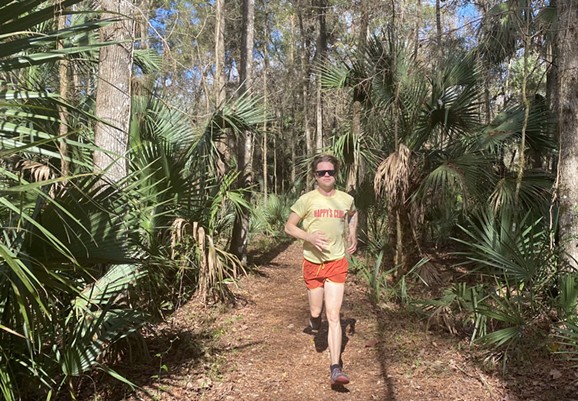While many people actually look forward to exercise and take pleasure in working up a good sweat, others find it difficult to just get up off the couch and onto the treadmill.
Cannabis could provide the incentive they need, say proponents of the plant.
“You kind of have to start a few hundred million years ago, with evolution and our reward system that incentivizes certain behaviors like learning, sex, sleep, food — things that will further our survival. And exercise is part of that,” says Josiah Hesse, the Denver author of Runner’s High who’s become a national advocate for the use of cannabis in exercise.
“We get pleasure from exercise, and that’s because of an endogenous cannabinoid called amandemine, which comes from the Sanskrit word for ‘bliss,’” Hesse explains. “It reduces pain and uplifts joy, and so there’s a natural runner’s high that people have been talking about for a long time. But since it is a cannabinoid, it can also be induced by a phytocannabinoid like THC.”
At the University of Colorado Boulder, the Study on Physical Activity and Cannabis Effects (SPACE) has been working with volunteers who have prior experience combining cannabis with exercise, recording their mental and physical status on a three-part test, including running for thirty minutes on a treadmill under the influence of either THC or CBD. The goal is to explore the possibility that cannabis enhances, rather than hinders, the exercise experience.
“We know that people who enjoy physical activity are more likely to do it more often and at higher intensities,” says Angela Bryan, a CU psychology and neuroscience professor who’s been working on SPACE since August. “And if cannabis can make people enjoy the activity more, make it less boring, make it more fun, then that might help people to be active.”

CU Boulder
Heather Mashhoodi, a champion local ultrarunner who has used the plant to her advantage while conquering long distances, is one of the SPACE participants. “I think it’s really context-dependent,” she explains. “In my experience, it’s kind of individualized.”
For her, popping an edible in the middle of a long run can go a long way. In April 2021, edibles helped Mashhoodi clock an FKT (Fastest Known Time) for the San Francisco Bay Circumnav via the Bay Area Ridge Trail: 12 days, 6 hours and 54 minutes. During and after this strenuous event, cannabis served as an effective substitute for Ibuprofen to relieve pain.
While SPACE is studying the pain-reduction and recovery potential of cannabis, it’s also focusing on the plant’s mental side effects. In Mashhoodi’s experience, cannabis consumption allows her to get out of her head and into her running environment.
“One of the questions in the study is about if you’re internalizing right now or externalizing, and where the majority of your thought patterns reside,” she says. “Like, am I thinking about how bad my knees hurt, or am I thinking about how pretty this tree is?”
Such externalization has become an essential part of many Coloradans’ exercise routines. Amanda Hitz, owner and founder of Bend & Blaze Yoga, a Denver yoga studio, considers cannabis a useful tool.
“The chatter in my mind can get quieter,” she explains. “If I really set an intention when I’m smoking, then I’ll get what I want out of the high. And for people who don’t really enjoy exercise or they find it hard to make it to the mat or make it to the gym, it kind of just takes the thinking process out of it.”
Because of COVID, Bend & Blaze is only occasionally hosting in-person classes these days, but it has daily Zoom sessions with instructors and participants from across the country. “We still set time aside before class to ‘sesh’ together and enjoy the community and conversations,” she notes, “but from the comfort of our own Zoom box.”
Since she held her first class in July 2015, Hitz says, combining marijuana with the curriculum has helped cultivate a tight-knit community. Rather than stay silent and focused, as is common at other studios, participants are encouraged to share their weed with one another and chat. “I guess Denver got ahold of me,” she notes, and laughs.

Before writing about the topic, Josiah Hesse personally discovered the effect edibles have on running.
Josiah Hesse
It’s gotten ahold of more than Hitz. Several other Colorado yoga studios merge meditation with marijuana, including Greenlove Denver and Twisted Sister Yoga in Denver, and Secret Stash Yoga in Colorado Springs.
In other states where marijuana is legal, Hesse estimates that anywhere from 60 to 80 percent of the athletes with whom he has spoken use cannabis in some form during their training or competitions — or both. “I would be hard-pressed to find an avenue of sports that cannabis isn’t used by the majority of its professional athletes,” he says. “Everything from the NHL to the MLB, the NFL to MMA. It’s popular with rock climbers, base jumpers, skiers, snowboarders, skateboarders…and it’s not just a few outliers here and there. It’s the majority.”
And some of them are defying the rules, albeit often in secret.
Sha’Carri Richardson’s use of cannabis became very public, though: The 21-year-old track star was disqualified from the 2021 Tokyo Olympics after testing positive for THC.
Some athletic organizations are now moving in a more weed-friendly direction. The National Basketball Association announced in 2021 that it will not randomly test players for marijuana. And the World Anti-Doping Agency has set up an advisory panel to consider whether cannabis should remain a prohibited substance after 2022.
As organizations re-evaluate their rules and experts work to end stereotypes, Hesse believes that athletes will be more open about their cannabis use and its benefits. Even so, he admits, “it will be a long time before you see the equivalent of Coors Field for the cannabis industry.”
from WordPress https://ift.tt/0h9oCO2
via IFTTT

No comments:
Post a Comment